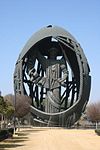Monastery of San Jerónimo de Buenavista, Seville
Christian monasteries established in the 15th centuryChristian monasteries in SpainFormer churches in SpainRoman Catholic churches in SevilleSpanish Christian monastery stubs

Monastery of San Jerónimo de Buenavista is a former monastery located in the San Jerónimo neighborhood of Seville, Andalusia, Spain. It was founded in 1414 by Father Diego Martínez de Medina. On 27 August 1964, it was declared a Historical-Artistic Monument. In 1966, it was bought by Carmen Iglesias Zubiada, who turned it into a private residence. In 1984, it was acquired by the Seville City Council. In 2015, it was turned into a neighborhood civic center.
Excerpt from the Wikipedia article Monastery of San Jerónimo de Buenavista, Seville (License: CC BY-SA 3.0, Authors, Images).Monastery of San Jerónimo de Buenavista, Seville
Calle Marruecos, Seville Distrito Norte
Geographical coordinates (GPS) Address Nearby Places Show on map
Geographical coordinates (GPS)
| Latitude | Longitude |
|---|---|
| N 37.423675 ° | E -5.986539 ° |
Address
Monasterio de San Jerónimo
Calle Marruecos
41015 Seville, Distrito Norte
Andalusia, Spain
Open on Google Maps











